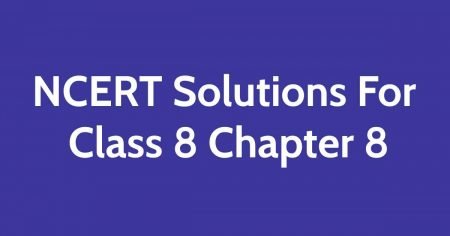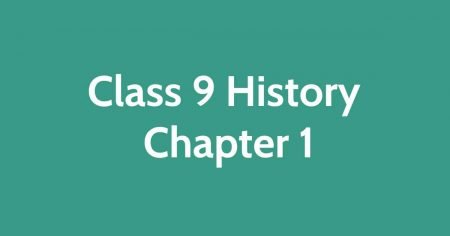NCERT Solutions for Class 10 Maths Chapter Wise: Class 10 is significant to every student because it will be the first time the students will be sitting for a board exam. Here the student needs to be well prepared for the board exam in all subjects particularly Maths. CBSE NCERT Solutions will assist students to have a deeper understanding of every concept in the textbook.
NCERT Solutions for Class 10 Maths Chapter Wise
Chapter 1: Real Numbers
In this chapter, the student will be taken through real numbers & irrational numbers. This chapter begins with Euclid’s Division-Lemma. It states that “provided with positive integers a & b, there are a distinct integers q & r which satisfies a=bq+r, 0≤r<b”. Euclid’s Division-algorithm is dependent on this lemma & is utilized to calculate the HCF of 2 positive integers. The Fundamental-Theorem of Arithmetic is explained and is used to get the LCM & HCF of 2 positive integers.
Chapter 2 – Polynomials
This chapter starts with explaining the degree of polynomial definition, quadratic polynomial, linear polynomial & cubic polynomial. In this chapter, the student will find a total of 4-Exercises. The first Exercise is explained by getting zeros of polynomials p(x). Exercise 2, is all about finding a quadratic polynomial. Exercise 2 is based on the relationship between 0’s & polynomial coefficients. Exercise 3 contains questions on polynomials division and the last Exercise has questions from every concept of polynomials.
After studying this chapter, the students should know the steps to derive Division-Algorithm for polynomials.
Chapter 3: Pair of Linear-Equations in 2 Variables
The student will learn the different ways of solving linear equations pairs. Moreover, this chapter has a total of 7-exercises, where the student will practice the different ways of solving linear equations pairs. Exercise 1 is about how to signify a situation graphically and algebraically. Exercise 2 is on ways of solving linear equation pairs using the Graphical Method. Exercises 3, 4, 5, and 6 explain the Algebraic, Elimination, Cross-Multiplication, and Substitution Methods, respectively. Exercise 7 has all kinds of questions.
Chapter 4: Quadratic Equations
Here, the students will understand the standard way of writing a Quadratic-Equation. Furthermore, this chapter explains the ways of solving quadratic equations by the factorization method & completing the square method. Furthermore, this chapter ends with a topic on getting the nature of roots stating that, a quadratic equation (ax²+bx+c=0) has
Two different real-roots, if b²–4ac>0
Two equal-roots, if b²–4ac=0
No real-roots, if b²–4ac<0
Chapter 5: Arithmetic Progressions
Here, the students will study what’s Arithmetic Progression, derivation of the nth term, getting the sum of first-nth terms of the Arithmetic Progression & solving the real-life questions using Arithmetic Progression.
Chapter 6: Triangles
This chapter gives information about the figures with similar shapes through different sizes. It describes the similarity of triangles, theorems linked with similarity of triangles & the concept of congruent triangles. Further, theorems which are related to parts of triangles, the converse of Pythagoras-theorem and Pythagoras theorem is explained.
Chapter 7: Coordinate Geometry
Chapter 7 explains the way a student can find the distance that’s in between two points whose coordinates are offered, & to get the area of a triangle created by 3 points. Moreover, the students will study how to get the coordinates of the point which shares a line segment combining two given points at a provided ratio. The students will also get introduced to Section Formula, Distance Formula & Area of a Triangle.
Chapter 8: Introduction to Trigonometry
Chapter 8 introduces Trigonometry. The student will study right triangle ratios concerning acute angles, known as trigonometric ratios of angles. Additionally, this chapter also explains trigonometric ratios of angles of 00 & 900. The student will also know on ways of calculating trigonometric ratios for specific angles & establish some identities which involve ratios known as trigonometric identities.
Chapter 9: Applications of Trigonometry
Concepts in this chapter are used in geography, construction of maps, navigation, determining the location of an island about latitudes and longitudes. Here, the students will understand how trigonometry is utilized to get the heights & distances of different objects, minus measuring them.
Chapter 10: Circles
Chapter 10, explains the various situations that arise when a circle & a line are provided in a plane.
Theorem 1: Tangent at a given point of a circle is at a right angle to the radius in a point of contact.
Theorem 2: Lengths of tangents that are drawn from an external-point to a circle are equivalent.
Chapter 11: Constructions
Chapter 11 is all about creating different geometric figures. Here the students will study how to divide a line-segment, & how to draw tangents on a circle. Construction methods are well expounded in this chapter.
Chapter 12: Areas Related to Circles
Chapter 12 starts with concepts of perimeter & area of a circle. This chapter further describes how to get an area of the sector & a segment of the circular region. Furthermore, students will understand how to get the areas of combinations of plane-figures that involve circles or their sections.
Chapter 13: Surface Areas & Volumes
This chapter explains on surface areas and volumes of different objects and shapes including cuboid, sphere, cone, cylinder, and hemisphere. Here, the student will also learn how to find the volume of objects which are made up of 2 different shapes. The student will also learn how to get the volume, total surface area, and curved surface area of a cone frustum.
Chapter 14: Statistics
Here, the students study the numerical representation of data, ungrouped or grouped. Additionally, they will further learn on finding the mean, mode, and median of the provided data. The concept of cumulative-frequency, drawing cumulative-frequency curves and cumulative frequency distribution is explained.
Chapter 15: Probability
Chapter 15 begins with a theoretical approach to probability. This chapter explains the difference between theoretical probability and experimental probability. This chapter has more examples that clarify the probability concept.



